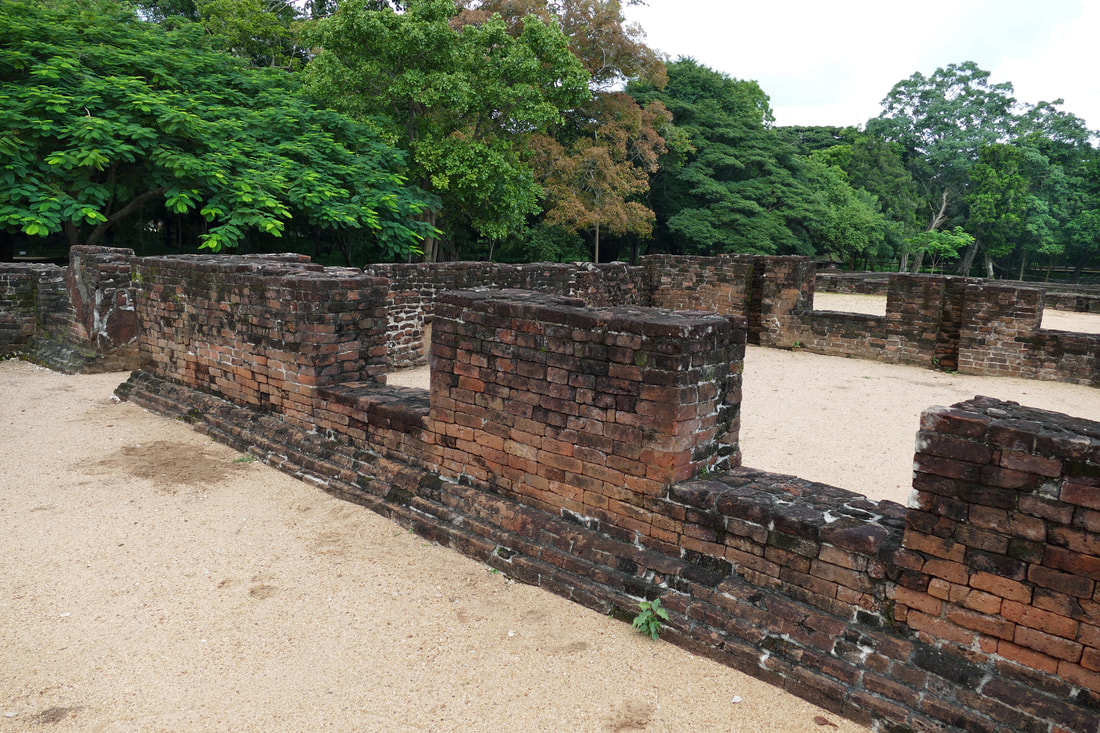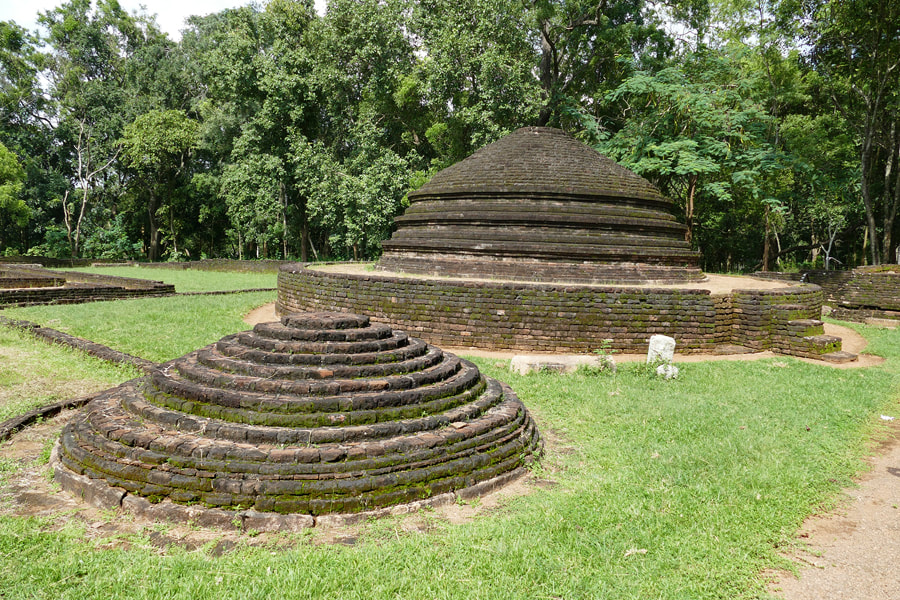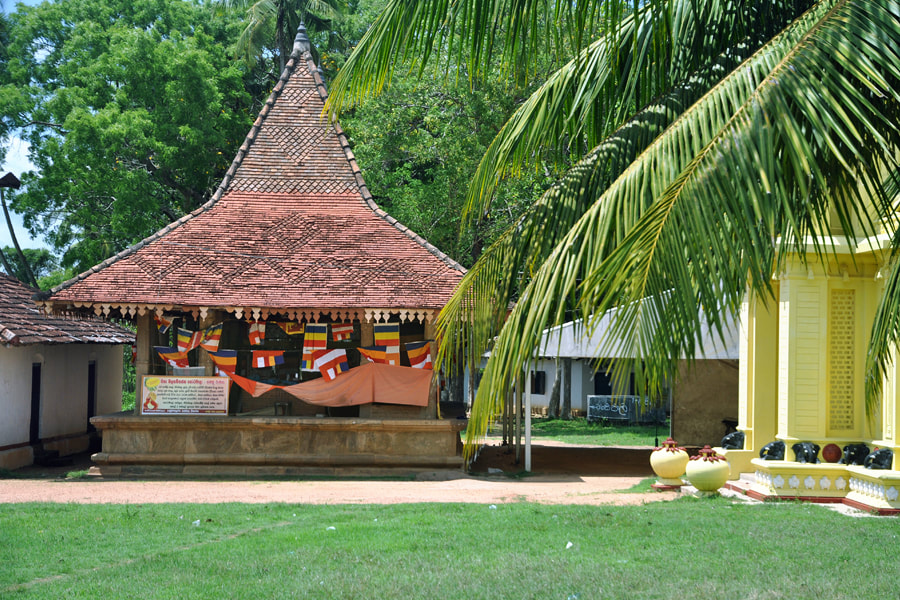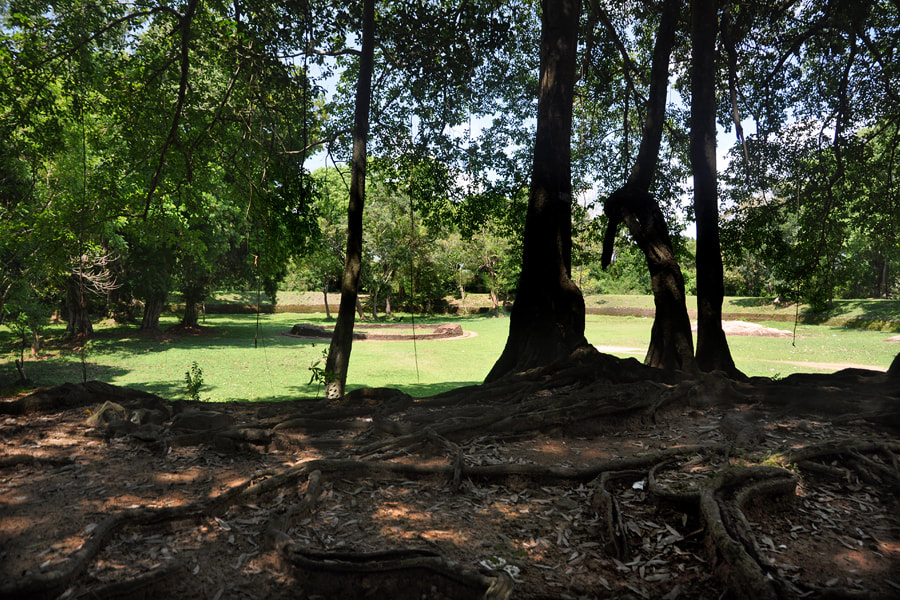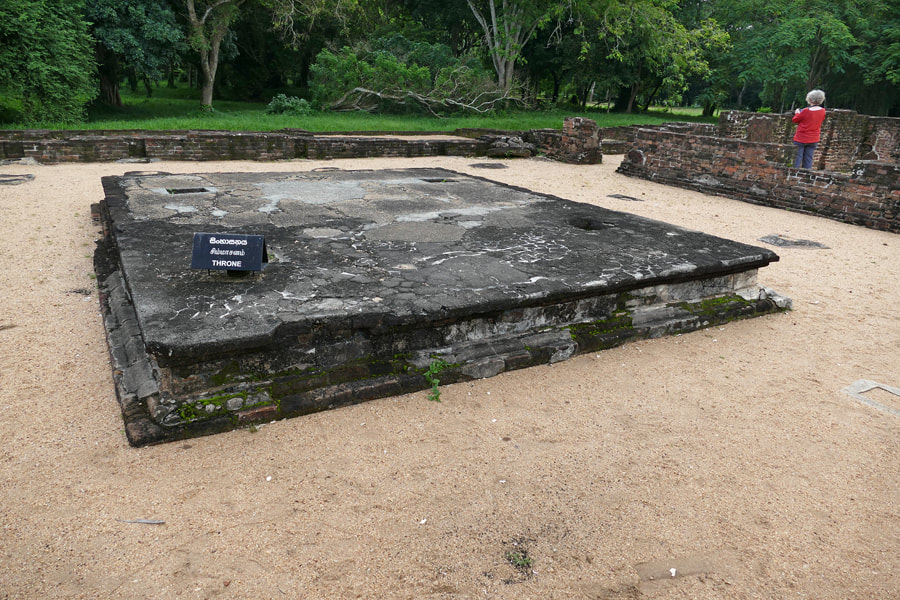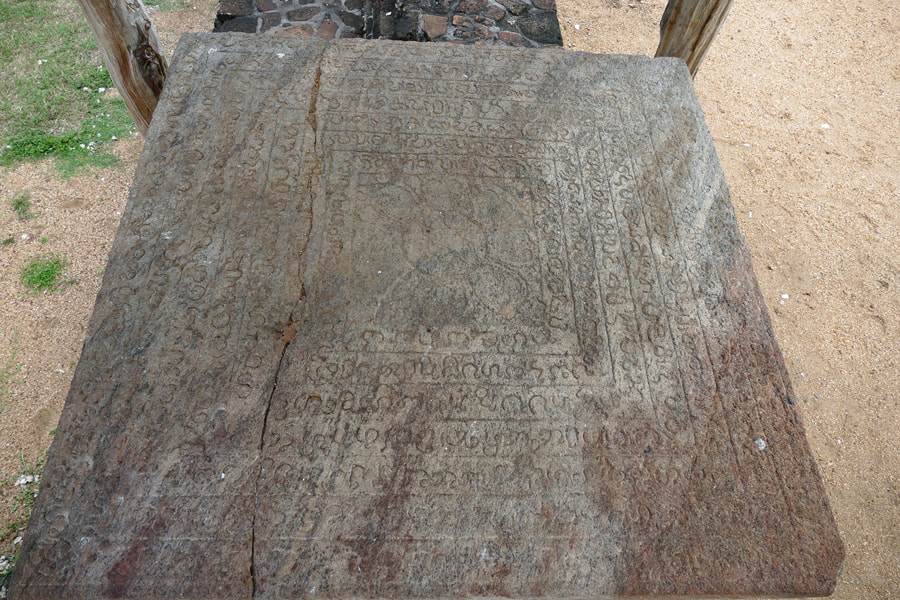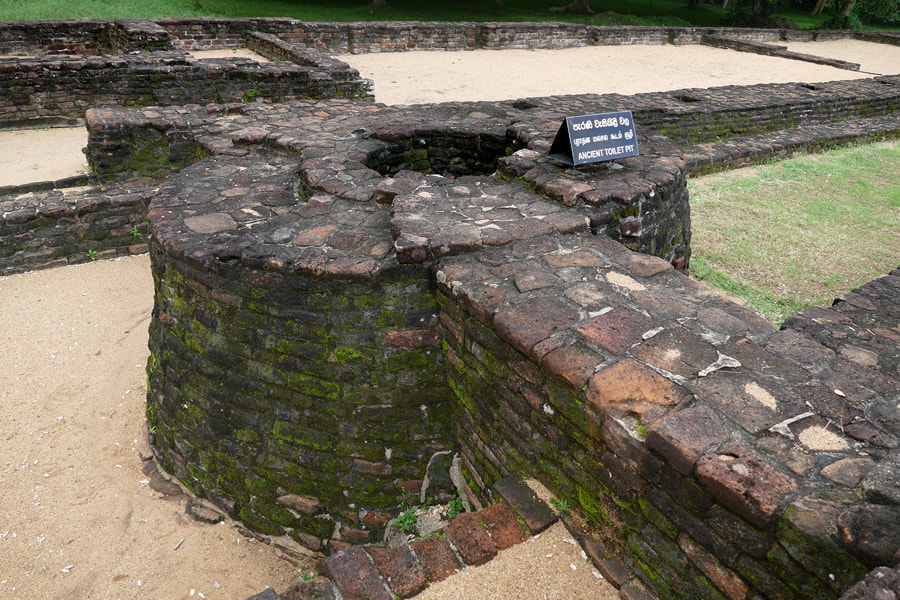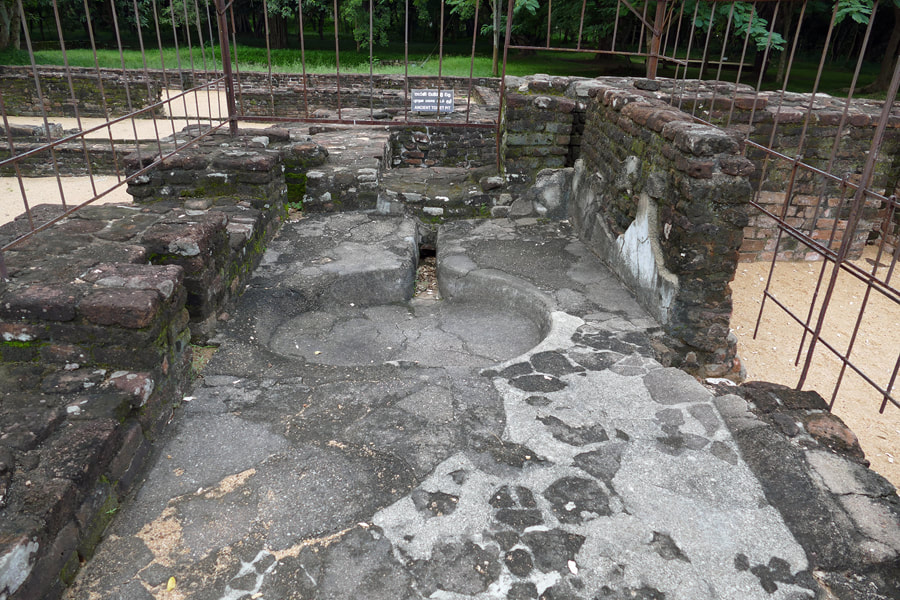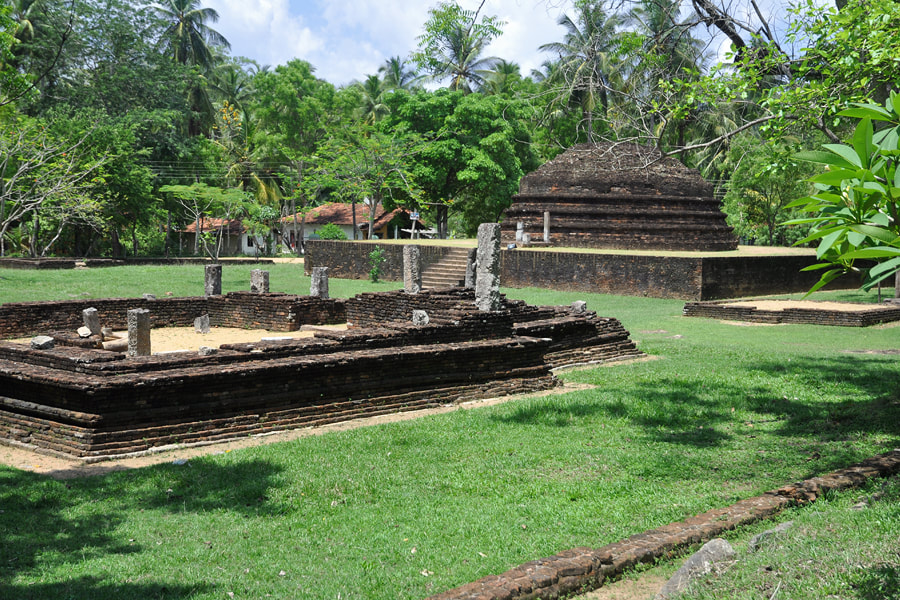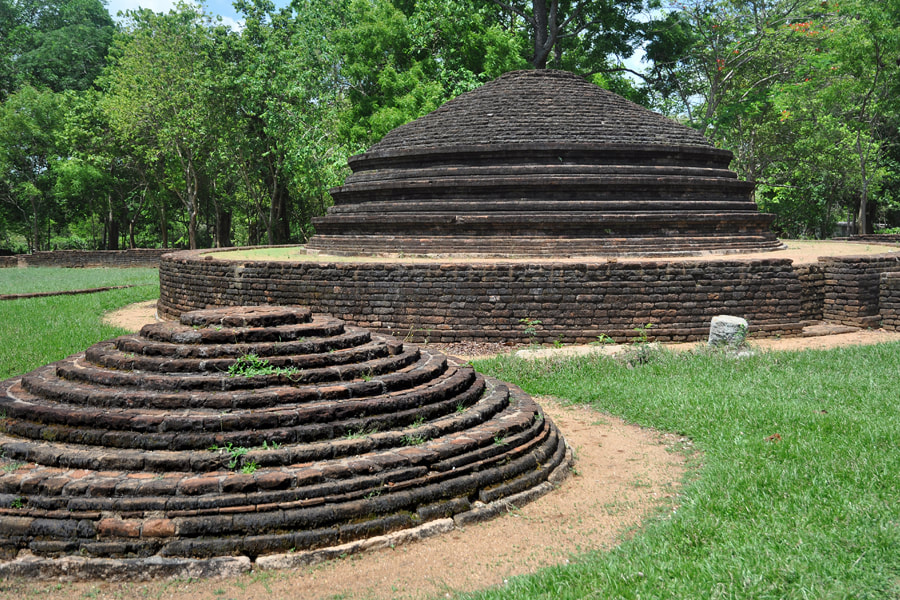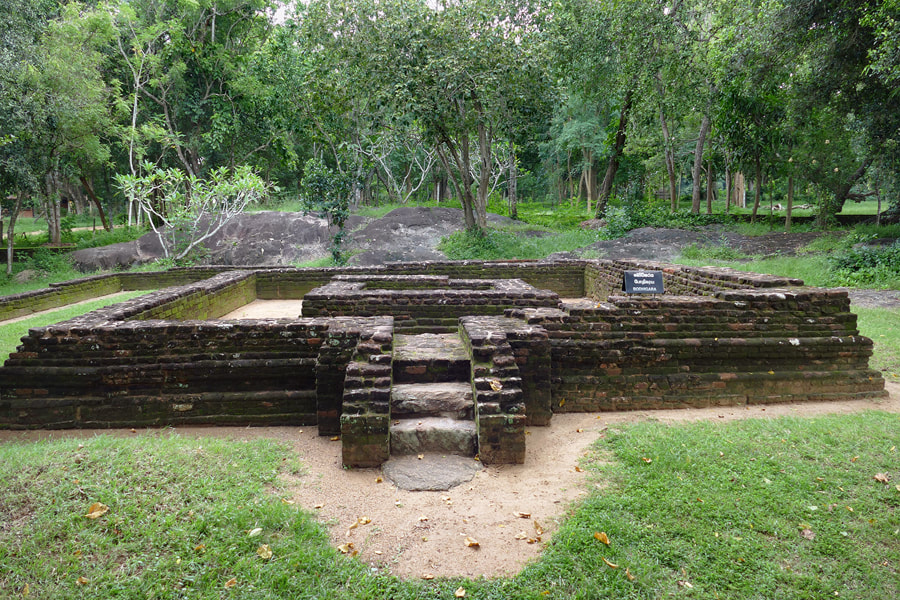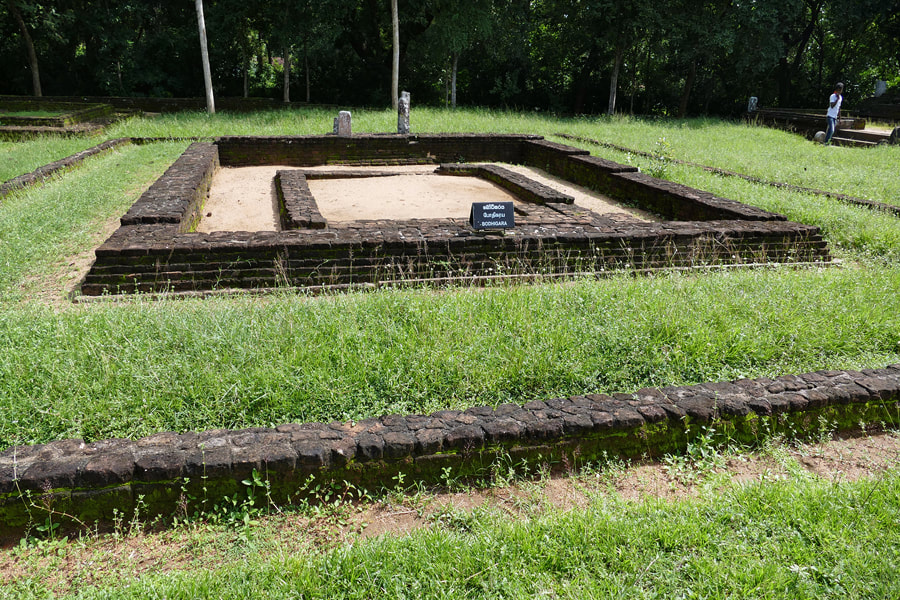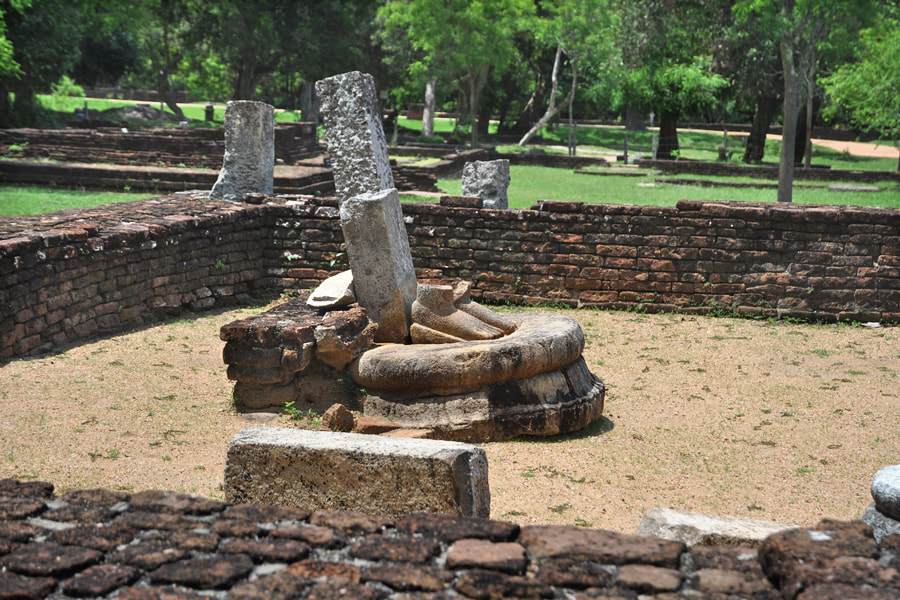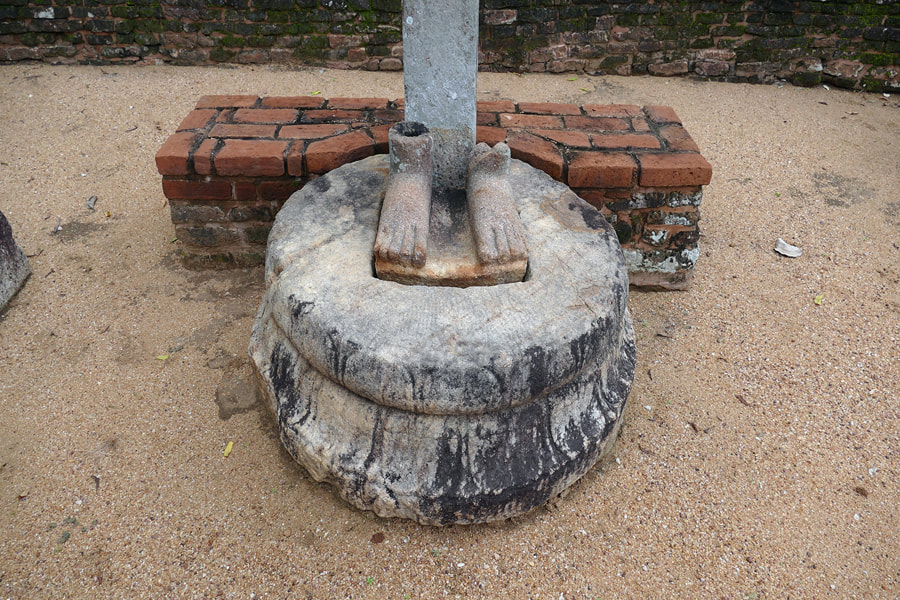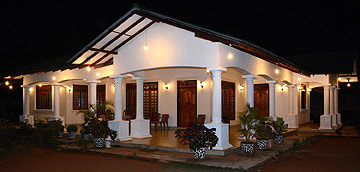Panduwasnuwara is the largest excavation site in Sri Lanka’s Northwestern Province. According to legends, it was the residence of King Panduvasdeva in the pre-Buddhist period of early Sinhalese history. What can be seen today are foundations walls of a city from the Middle Ages. Historically, Panduwasnuwara was the capital of the principality reigned by Parakramabahu the Great before he succeeded in unifying the country as the most important king of the Pollonaruwa period. In a sense, Panduwasnuwara was the prototype of his royal residence in Polonnaruwa.
Frankly speaking, Panduwasnuwara is not a must-see for heritage travellers with only a limited time frame. But it’s off the beaten path and therefore less crowded than other heritage site and Panduwasnuwara, besides Dedigama, is definitely the most important archaeological site from the Polonnaruwa period in the west of Sri Lanka get. The excavation site is unspectacular, both in terms of the flat landscape and also the plane remnants of historical buildings. After all, the ruins are quite extensive, stretching over a large area. And at least one item is quite unique in Sri Lanka, namely the Chakrawalaya, a wide circular square. A ring wall of comparable size is otherwise not known from the architecture of the ancient Sinhalese civilization.
Besides an overview section for quick information,
you can also find detailed descriptions, by clicking the light blue tabs "palace" or "temples" below...
you can also find detailed descriptions, by clicking the light blue tabs "palace" or "temples" below...
-
overview
-
history
-
palace
-
temples
-
museum
<
>
What to see in Panduwasnuwara
|
Half of the area excavation site of Panduwasnuwara is occupied by a citadel, the layout of which is an oblong rectangle bounded by a moat and a wall with a royal palace almost in the centre. The royal palace had a courtyard framed by symmetrically arranged brick structures. Among the noteworthy features are a terrace of the throne, an inscription stone and remnants of a medieval sanatory installation.
|
|
Neighbouring the southeastern corner of the citadel, two monastic complexes are situated in close proximity to one another. Both compounds feature monk cells and all of the classical four or five types of Sinhalese monastic architecture: chapter hall, stupa, Bo-tree sanctuary, image houses. One of the two main stupas is built on a circular platform. Not much has remained from the statues of the image houses.
|
|
The modern Vihara of Panduwasnuwara, carrying the name of the excavation site, is sligthly further south. Most of the buildings of the Panduwasnuwara temple are modern. But one edifice is remarkable, as it is a Kandyan-style wooden hall (18th century) on a platform from the Polonnaruwa period (12th century). This structure is claimed to have been the Tooth Temple during the period of Parakramabahu ruling in Panduwasnuwara, before he shifted his residence to Polonnaruwa. However, it's unlikely that a Tooth Temple ever existed in Panduwasnuwara.
|
|
The most remarkable structure of Panduwasnuwara is a circular rampart with a smaller circular structure in the veryy centre. This layout is unique in Sri Lanka. And it's unknown what purpose this large "arena" served for. Local legends claim that it was the prison of Ummada Chitta, mother of Pandukabhaya, who became the first king of Anuradhapura. As Ummada Chitta was held captive in the residence of her father, King Panduvadewa, the modern Sinhalese name of the entire site, Panduwasudewa, refers to this legendary king.
|
Name of Panduwasnuwara
|
The most common Latin or English transliterations of the Sinhala name of the place are “Panduwasnuwara” and “Panduwas Nuwara”. However, since the place is named after an early Sinhalese king whose Pali name is usually spelt “Panduvasdewa” or “Panduvasudewa” or “Panduvasdewa” (though also “Panduwas Dev”), the Latin spelling “Panduwasnuwara” also makes sense, as it is common (though not a rule) to use “w” in endings but “v” for the same semi-vowel or consonant otherwise. In Sinhala, “Nuwara” simply means “city”.
Hence, “Panduwasnuwara” translates to “Panduva’s city” or “Panduvasdewa’s city”. Though the modern Sinhala name, as said, refers to a king from the very early period of Sinhalese history, the Pali toponym mentioned in medieval chronicles, “Parakramapura”, is named after a much later king. The meaning was “Parakrarama’s city” or “Parakramabahu’s city”. Indeed, the king later on called Parakramabahu the Great was the one who initiated the most ambitious construction program in Panduwasnuwara and surroundings. |
King PanduvasdewaPanduvasdewa is said to have been the nephew and second successor of Vijaya, who had been the leader of the first Sinhala immigrants and as such is counted as the first Sinhalese king. After his death, his companion and Minister Upatissa had taken over the reign for only a short period, until Vijaya's relative Panduvasdewa, who was invited to ascend to the throne, arrived from India. According to local folklore, Panduwasnuwara was one of the settlements or even the capital founded by this third Sinhalese ruler (according to another count: the second Sinhalese king). In this case, the city would date back to the 5th century BC. But there is no archaeological evidence so far that could trace back structures to that early period. |
History of Panduwasnuwara
Panduwasnuwara is the second most important excavation site from the Polonnaruwa period. It must have been a place of some significance already prior to that, as inscriptions belonging to 9th -10th century can be seen in the premises of a Tampita temple (wooden shrine on pillars), which is from the Kandyan period. The said inscriptions are on slabs, as it is common in the late Anuradhapura period. Two inscriptions, of which only the beginnings have survived, say they are from the 30th resp. 34th regnal year of his Majesty Sirisanghabo. The latter word is used similar to a title, not indicating the personal name of the king. It's likely that the two said inscriptions are from the period of the monarch Sena II, who indeed reigned fro such a long period in the second half of the 9th century. A 3rd inscription was issued by a local official who claims to be commissioned by Pandirad Salaya. This was a state official of King Kassapa IV in the early 10th century.
Most of the ruins that can be seen today are remnants of structures from the 12th century, this means, from the period of Parakramabahu I, who, before being crowned in Polonnaruwa, had been the ruler of the west of the island, which was then known as Dakkhinadesa. It was during those early days of his carrier that he chose Panduwasnuwara as his capital to reign the western plains of the island. As a competent ruler, he effectively developed the wide surroundings by constructing medium-sized tanks. Panduwasnuwara became a kind of flagship royal residence, with the best-structured administration of Sri Lanka those days. Parakramabahu then used as a model for his rule in Polonnaruwa, where his reigns marks the climax of centralized government in the pre-colonial history of Sri Lanka.
A Tamil inscription by a minister of Parakramabahu indicates a harmonious cooperation of Sinhala and Tamil ethnic groups in this well-ordered part of the empire. Dakkhinadesa became the most prosperous part of Sri Lanka during the heydays of Panduwasnuwara. It was from this base that Parakramabahu reached for the crown in Polonnaruwa. The struggle against his former patron Gajabahu dragged on for a long time, and the fortunes of war changed repeatedly. In the end, a peace treaty was negotiated with the help of the Buddhist clergy, well-disposed towards Parakrambahu like towards his father Manabharana previously. The treaty provided that Parakrambahu, although only a second-degree nephew and brother-in-law, should succeed Gajabahu II after his death as king in Polonnaruwa. More precisely: Gajabahu and Parakramabahu mutually appointed each other to heirs of their respective kingdoms, but Parakramabahu was much younger than Gajabahu, so he was expected to become the successor of Gajabahu II as a result of this agreement. Gajabahu himself had no sons. Right before his death he reconfirmed the succession in writing.
Only one generation after the long reign of Parakrambahu in Polonnaruwa, Parakramapura, as Panduwasnuwara was called in the chronicles, suffered the same fate as Polonnaruwa. It was fell into decay during a period of wars and was finally abandoned by its inhabitants and never rebuilt
Systematic excavation works in Panduwasnuwara began comparatively late, in 1947, this means in the very late days of the colonial period. Most of the scientific research at this archaeological site was undertaken only after independence.
Most of the ruins that can be seen today are remnants of structures from the 12th century, this means, from the period of Parakramabahu I, who, before being crowned in Polonnaruwa, had been the ruler of the west of the island, which was then known as Dakkhinadesa. It was during those early days of his carrier that he chose Panduwasnuwara as his capital to reign the western plains of the island. As a competent ruler, he effectively developed the wide surroundings by constructing medium-sized tanks. Panduwasnuwara became a kind of flagship royal residence, with the best-structured administration of Sri Lanka those days. Parakramabahu then used as a model for his rule in Polonnaruwa, where his reigns marks the climax of centralized government in the pre-colonial history of Sri Lanka.
A Tamil inscription by a minister of Parakramabahu indicates a harmonious cooperation of Sinhala and Tamil ethnic groups in this well-ordered part of the empire. Dakkhinadesa became the most prosperous part of Sri Lanka during the heydays of Panduwasnuwara. It was from this base that Parakramabahu reached for the crown in Polonnaruwa. The struggle against his former patron Gajabahu dragged on for a long time, and the fortunes of war changed repeatedly. In the end, a peace treaty was negotiated with the help of the Buddhist clergy, well-disposed towards Parakrambahu like towards his father Manabharana previously. The treaty provided that Parakrambahu, although only a second-degree nephew and brother-in-law, should succeed Gajabahu II after his death as king in Polonnaruwa. More precisely: Gajabahu and Parakramabahu mutually appointed each other to heirs of their respective kingdoms, but Parakramabahu was much younger than Gajabahu, so he was expected to become the successor of Gajabahu II as a result of this agreement. Gajabahu himself had no sons. Right before his death he reconfirmed the succession in writing.
Only one generation after the long reign of Parakrambahu in Polonnaruwa, Parakramapura, as Panduwasnuwara was called in the chronicles, suffered the same fate as Polonnaruwa. It was fell into decay during a period of wars and was finally abandoned by its inhabitants and never rebuilt
Systematic excavation works in Panduwasnuwara began comparatively late, in 1947, this means in the very late days of the colonial period. Most of the scientific research at this archaeological site was undertaken only after independence.
Early years of Parakramabahu I
After the death of the first Polonnaruwa king, Vijayabahu I in 1110, his younger brother Jayabahu ascended the throne in accordance with the Sinhalese rules of succession. However, these rules also would have provided Vijayabahu's son Vikramabahu to become the next hair apparent. But the new king chose another nephew as the new crown prince, namely Manabharana, whose father was from the Pandya family, a South Indian Tamil dynasty reigning in Madurai. Manabharana thereby introduced a Pandyan branch of the Sinhalese royal family. Despite his Tamil and Hind ancestry, Manabharana was favoured by the Buddhist clergy in particular, and maybe this was decisive in establishong him as the new heir apparent in Polonnaruwa. Anyway, the Pandyas were considered allies against the predominant Tamil empire those days, the Cholas. Understandably, Vijayabahu’s son Vikramabahu felt overlooked. He commenced to fight for his claims to the throne in Polonnaruwa and succeeded in ousting Manabharana, who evaded further defeat by retreating to the southwest of the island, the region he had already administered as heir to the throne. Manabharana ruled this part of the country effectively.
Manabharana remained without son for a long period. It was only in his old age that, contrary to expectations, a son was born to him, Parakramabahu, who much later on gained the throne in Polonnaruwa and secured the triumph of the Pandyan line. Parakramabahu was too young to take control of the western principality immediately after the death of his father. Instead. after Manabharana's demise his brother Kittisirimegha initially ascended the throne in Dakkhinadesa. The power-conscious young prince Parakramabahu did not remain long at the royal court of his powerful uncle Kittisiremegha, he had to flee temporarily to Polonnaruwa, where King Gajabahu generously supported the young man with whom he was distantly related.
Only after Kittisirimegha's death around 1140, Parakramabahu finally took control of Dakkhinadesa. Immediately after coming to power, he chose a new capital. Panduwasnuwara, under the name of Parakramapura, soon became Sri Lanka’s second most important city in the Polonnaruwa period. Parakramabahu proved to be a master of state control. He created an effective administrative structure in Dakkhinadesa by creating a financial department headed by a prime minister that was independent of the military command. Due to the effectiveness of his administration in this previously neglected part of the island, Parakramabahu was able to develop new paddy cultivation areas by expanding earlier irrigation projects on a large scale. The main river of his principality was Deduru Oya River, which 15 kilometers north of Panduwasnuwara flows in an east-west direction. The most famous quote from the future king in Polonnaruwa dates already from this early period, when he was a regional ruler in Panduwasnuwara: Not one single drop of water should reach the ocean without first being used for the benefit of the people.
By the way, this is a quote from the continuation of the Mahavansa Chronicle, which is sometimes called Chulavansa (a name introduced by the German scholar Wilhelm Geiger). The quote can be found in verse 68:11.
Verses 68: 23-40 report the irrigation projects in the river network of the Deduru Oya in some detail. The river was called Jajjara Nadi those days.Three dams were constructed across the river, Kotthaadda, Sukhara Nijjara, and Doradattika. Old tanks and canals were restored and new ones were constructed in a systematical approach, in order to form an entire irrigation network. This scheme served as model for later similar measures in the region of Polonnaruwa, after Parakramabahu had become the king in this medieval Sinhalese capital.
There is a long list of tanks mentioned in the chronicles as works of merit of Parakramabahu already during the period of his reign in Panduwasnuwara. Among them is Magalle Wewa near Nikaweratiya, just north of Panduwasnuwara, is one of the new reservoirs at Deduru Oya that were created under the direction of Parakrambahu. In the chronicles the tank as called Mahagallaka. The king also expanded the Pandavapi (now called Pandawewa) further upstream, which had already been constructed by Vijayabahu, the first king of the Polonnaruwa period (It’s sometimes considered to have be the oldest tank of the island). The enlarged reservoir was of such a size that it was called a "sea" ("Samudra"). Similarly, the Topawewa near Polonnaruwa after its expansion became known as the "Sea of Parakramabahu" ("Parakrama Samudra") later on. Today, the reservoir called Pandawewa is much smaller than that giant reservoir of the Middle Ages constructed by Parakramabahu. For the water and rice supply of his then capital, today’s Panduwasnuwara., another reservoir lay to the west of the city.
In addition, Parakramabahu was the first monarch to develop the wet region to the south of the Kelani River near Colombo systematically. He did so by draining the marshes in the region of Pasdun Korale in the hinterland of Kalutara..
Furthermore, Parakramabhu set up a separate department to control and promote and export the gemstones from Ratnapura. The office of the interior, in charge of the mining and trading of gems and other minerals and metals, was known as Antharangadhura. The ports on the west coast were expanded for improving international trading relations. The gem trade had been the privilege of the kings in the Anuradhapura period. That Parakramabhu managed the gem trade indicates that he – in the western plains of Sri Lanka – already had the authority and prestige of a king indeed, besides being effectively in control of his part of the island, in fact independent despite Polononaruwa’s claim of overlordship over the entire island.
Manabharana remained without son for a long period. It was only in his old age that, contrary to expectations, a son was born to him, Parakramabahu, who much later on gained the throne in Polonnaruwa and secured the triumph of the Pandyan line. Parakramabahu was too young to take control of the western principality immediately after the death of his father. Instead. after Manabharana's demise his brother Kittisirimegha initially ascended the throne in Dakkhinadesa. The power-conscious young prince Parakramabahu did not remain long at the royal court of his powerful uncle Kittisiremegha, he had to flee temporarily to Polonnaruwa, where King Gajabahu generously supported the young man with whom he was distantly related.
Only after Kittisirimegha's death around 1140, Parakramabahu finally took control of Dakkhinadesa. Immediately after coming to power, he chose a new capital. Panduwasnuwara, under the name of Parakramapura, soon became Sri Lanka’s second most important city in the Polonnaruwa period. Parakramabahu proved to be a master of state control. He created an effective administrative structure in Dakkhinadesa by creating a financial department headed by a prime minister that was independent of the military command. Due to the effectiveness of his administration in this previously neglected part of the island, Parakramabahu was able to develop new paddy cultivation areas by expanding earlier irrigation projects on a large scale. The main river of his principality was Deduru Oya River, which 15 kilometers north of Panduwasnuwara flows in an east-west direction. The most famous quote from the future king in Polonnaruwa dates already from this early period, when he was a regional ruler in Panduwasnuwara: Not one single drop of water should reach the ocean without first being used for the benefit of the people.
By the way, this is a quote from the continuation of the Mahavansa Chronicle, which is sometimes called Chulavansa (a name introduced by the German scholar Wilhelm Geiger). The quote can be found in verse 68:11.
Verses 68: 23-40 report the irrigation projects in the river network of the Deduru Oya in some detail. The river was called Jajjara Nadi those days.Three dams were constructed across the river, Kotthaadda, Sukhara Nijjara, and Doradattika. Old tanks and canals were restored and new ones were constructed in a systematical approach, in order to form an entire irrigation network. This scheme served as model for later similar measures in the region of Polonnaruwa, after Parakramabahu had become the king in this medieval Sinhalese capital.
There is a long list of tanks mentioned in the chronicles as works of merit of Parakramabahu already during the period of his reign in Panduwasnuwara. Among them is Magalle Wewa near Nikaweratiya, just north of Panduwasnuwara, is one of the new reservoirs at Deduru Oya that were created under the direction of Parakrambahu. In the chronicles the tank as called Mahagallaka. The king also expanded the Pandavapi (now called Pandawewa) further upstream, which had already been constructed by Vijayabahu, the first king of the Polonnaruwa period (It’s sometimes considered to have be the oldest tank of the island). The enlarged reservoir was of such a size that it was called a "sea" ("Samudra"). Similarly, the Topawewa near Polonnaruwa after its expansion became known as the "Sea of Parakramabahu" ("Parakrama Samudra") later on. Today, the reservoir called Pandawewa is much smaller than that giant reservoir of the Middle Ages constructed by Parakramabahu. For the water and rice supply of his then capital, today’s Panduwasnuwara., another reservoir lay to the west of the city.
In addition, Parakramabahu was the first monarch to develop the wet region to the south of the Kelani River near Colombo systematically. He did so by draining the marshes in the region of Pasdun Korale in the hinterland of Kalutara..
Furthermore, Parakramabhu set up a separate department to control and promote and export the gemstones from Ratnapura. The office of the interior, in charge of the mining and trading of gems and other minerals and metals, was known as Antharangadhura. The ports on the west coast were expanded for improving international trading relations. The gem trade had been the privilege of the kings in the Anuradhapura period. That Parakramabhu managed the gem trade indicates that he – in the western plains of Sri Lanka – already had the authority and prestige of a king indeed, besides being effectively in control of his part of the island, in fact independent despite Polononaruwa’s claim of overlordship over the entire island.
Citadel with Palace of Parakramabahu in Panduwasnuwara
The royal residential quarter part of Parakramapura - as Panduwasnuwara was called in the chronicles - is bounded with moat measuring 16 m in width and a brick rampart measuring 2.5 m at the base. It was reduced to half at the upper levels, but now only foundations can still be seen at most places. The entrance to the royal citadel was from the east. The gateway was flanked by a set of guardroms.
Due to the lack of the original height, this citadel and palace are not as impressive any more as they must have been in the 12th century. The walled district has an almost square extension of 310m by 330m, it forms only half of the 20 hectares large excavation site that has been explored to date, which in turn only was the royal and ceremonial part of the entire area of the former residence city of Parakramabahus.
Due to the lack of the original height, this citadel and palace are not as impressive any more as they must have been in the 12th century. The walled district has an almost square extension of 310m by 330m, it forms only half of the 20 hectares large excavation site that has been explored to date, which in turn only was the royal and ceremonial part of the entire area of the former residence city of Parakramabahus.
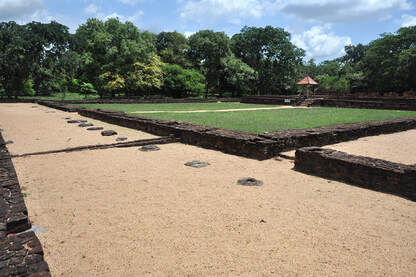
So, advancing from the entrance, the first large complex visitors come to see is the citadel, the former royal quarter of Parakramabahu. Within the citadel, there is a royal residence measuring 108 m by 100 in the center, which was fortified with another wall. A similar double ring of walls around the royal residence – with religious sanctuaries only in the unprotected foreland of the fortified city - also occurs in the groundplan of Polonnaruwa, in even larger dimensions.
Hardly any more than the floor plan of the former royal palace can be seen, as it was a brick and wood structure from which only the foundation walls and pillar anchors and some stumps have been preserved. However, there are some guard stones still in situ, similar to those at temple buildings. Panduwasnuwara’s Palace is of interest for those interested in studying groundplans and details, but it’s not a paradise for photographers.
Hardly any more than the floor plan of the former royal palace can be seen, as it was a brick and wood structure from which only the foundation walls and pillar anchors and some stumps have been preserved. However, there are some guard stones still in situ, similar to those at temple buildings. Panduwasnuwara’s Palace is of interest for those interested in studying groundplans and details, but it’s not a paradise for photographers.
 photo courtesy of Günter Schönlein
photo courtesy of Günter Schönlein
The royal palace comprised two interconnected areas, the outer one being the living area with numerous small rooms. The inner compartment probably served administrative and representational purposes. Columns surrounded the central main palace building measuring 36m by 27m, the rooms of which were grouped around an open courtyard, similar to the later Parakramabahus palace in Polonnaruwa. It’s likely that the royal palace in Panduwasnuwara served as a prototype of the latter. The inner courtyard is called Meda Midula. As in Polonnaruwa, the local palace with wooden structures is said to have originally been multi-storey.
Just in in front of the central palace, there is a throne made of stone. Locals tend to believe that this altar-like was the base as the throne of Parakramabahu. This assumption is not entirely implausible. But it’s more likely the said throne was erected by Parakramabahu’s (third) successor, Nissanka Malla of Polonnaruwa, and that a much wider pedestal served as Parakramabahu’s throne during the period of his reign in Panduwasnuwara. An inscription at the first-mentioned throne, the so-called Asana (seat), says that King Nissanka Malla used the throne to see dance performances when he was on his way back from his pilgrimage to Siri Pada (Adam’s Peak):
|
“King Nissankamalla was seated here, in his ninth year of reign, on a full-moon day of the month of Navam (Hanuary-February) watching dances, music and songs. He donated five "tulabhara" (Gave ornament to his own weight) annually.”
|
Mention is also made of the king subjugating the territories of Kalinga Pandya and Chola. Nissanka Malla left inscriptions at Adam’s Peak and many other places in Sri Lanka he visited on so-called pilgrimages which also served inspection purposes. The king is well-known not only for the sheer number of inscriptions but also for their boasting style. The fact that he left one of his traces in Panduwasnuwara suggests that the city remained to be a significant place when Parakramabahu moved to Polonnaruwa and continued to be a major city even after his death. It is assumed, that during the heydays of the Polonnaruwa period (second half of the 12th century) Panduwasnuwara was indeed the second largest town on the island, even more populated than the former capital Anuradhapura (despite the latter was still the official capital at that point in time).
Medieval sanitation technology can still be seen behind the northwest corner of the palace. The cement of the pit is original. A drain made of stone allowed the unclean water to flow from the toilet basin into a pit, which is made of bricks. It was originally covered at the top. Due to damage caused by vandalism or treasure hunting, the sanitary structure is now fenced. Furthermore, there are six small ponds behin the palace.
Monastic complexes and Circular Rampart in Panduwasnuwara
To the south of this residential town was the monastic area, easily recognisable due to the stupa buildings. Presumably, there was more than one Buddhist fraternity in Panduwasnuwara, Though in close neighbourhood to one another, the two compounds with stupas next to the east gate of the royal citadel were probably two independent Viharas, i.e. two sparate monasteries. Even more religious complexes can be found, there might also have been a monastic complex to the north of the royal palace (now at the opposite side of the main road).
In contrast to most other stupa buildings, one of main stupas of the said 2 monastic complexes just to the southeast of the Panduwasnuwara citadel stands on circular instead of square terraces or even on ground level. Smaller stupas surrounding the main stupa may have served as urn tombs of highly respected monks, like in the cases of Kantharodai on Jaffna Peninsula or Alahena Pirivena in Polonnaruwa, where large numbers of small stupas stand side by side.
The said main stupas are also surrounded by several former image houses. Such shrines for the veneration of Buddha statues are called Pathimagara in Pali or Pilimage in Sinhala. Apart from the stupa and image houses, remnants of the other typical monastic edifices of a Sinhalese monastery can be seen as well, assembly hall and Bodhigara. Both temple compounds had Bodhigaras, small structures once surrounding a sacred Bo-tree. The square bed for the tree is bounded by an interior brick wall. The groundplan of both Bodhigaras can still be identified easily.
The said main stupas are also surrounded by several former image houses. Such shrines for the veneration of Buddha statues are called Pathimagara in Pali or Pilimage in Sinhala. Apart from the stupa and image houses, remnants of the other typical monastic edifices of a Sinhalese monastery can be seen as well, assembly hall and Bodhigara. Both temple compounds had Bodhigaras, small structures once surrounding a sacred Bo-tree. The square bed for the tree is bounded by an interior brick wall. The groundplan of both Bodhigaras can still be identified easily.
Furthermore, there are accommodation quarters for Buddhist monks. Though all four classic types of sacred buildings occur in the Vihara compound, they are neither arranged in the regular Panchayathana style of Indian architecture (although the latter is claimed in many online articles about Panduwasnuwara) nor in one of the symmetrical Pabbata Vihara layouts of monasteries of the late Anuradhapura period.
There is also an image house in front of the second stupa. Another such Pilimage has a reclining Buddha of which only the brick foundation remains. At that second stupa, an inscription mentions an otherwise unknown king named Parakramabahu Nissankamalla, an odd combination of the names of the two most famous rulers of the 12th century.
There is also an image house in front of the second stupa. Another such Pilimage has a reclining Buddha of which only the brick foundation remains. At that second stupa, an inscription mentions an otherwise unknown king named Parakramabahu Nissankamalla, an odd combination of the names of the two most famous rulers of the 12th century.
Within the Pilimiges are spare remnants of the ancient statues, for example a lotus pedestal of a Buddha statue, of which only the feet have been preserved.
So-called Tooth Temple of Panduwasnuwara
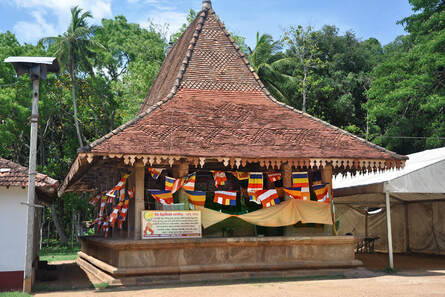
Even further southeast the visitor arrives at open pavilion with a striking roof in the Kandyan style, which was only added in the 1970s.
The pedestal is from the Polonnaruwa period indeed. Most probably, it belonged to a tree sanctuary, one more former Bodhigara. But locals refer to this construction as a tooth temple, for which assumption there is little evidence. Only since Panduwasnuwara was the capital for a short time, it must have had one, seems to be the assumption. But the Chulavamsa chronicle makes no mention of any transfer of this national palladium to Panduwasnuwara.
The pedestal is from the Polonnaruwa period indeed. Most probably, it belonged to a tree sanctuary, one more former Bodhigara. But locals refer to this construction as a tooth temple, for which assumption there is little evidence. Only since Panduwasnuwara was the capital for a short time, it must have had one, seems to be the assumption. But the Chulavamsa chronicle makes no mention of any transfer of this national palladium to Panduwasnuwara.
In some online articles it is even claimed that Parakramabahu brought it back the Tooth Relic to Sri Lanka, after Indian invaders had captured it, and then kept it in Panduwasnuwara. However, this is a mix-up with events of a much later period. It was during the Dambadeniya and Yapahuwa period in the 13th century that the Tooth Relic was temporarily kept in India. In the 12th century, the Tooth Relic was also removed from Polonnaruwa, but not to India. Rather, Buddhist monks brought it to the southern principality of Rohana due to turmoils at the royal court in Polonnaruwa. Indeed, Parakramabahu fought for the Tooth Relic even prior to his coronation in Polonnaruwa. This was when the ruler or king of the south (also named Manabharana, but not to be confused with Parakramabahu’s father of the same name) temporarily succeeded in conquering Polonnaruwa. The Sacred Tooth then was brought back from Rohana to Polonnaruwa, but only for a short while. Those days, Parakramabahu, though usually an opponent of Gajabahu II of Polonnaruwa, became his allie to expel the invaders who were Sinhalese from the south of the island and not Indians. He succeeded in driving them out of Polonnaruwa but not in capturing the Tooth Relic, which then was only conveyed to Rohana again. Because the Tooth Relic was in Rohana, when Parakramabhu after the demise of Gajabahu finally became king in Polonnaruwa, the war for control over the island was not yet over. Parakramabahu now commenced a much harder fought campaign against Rohana than previously against Polonnaruwa. And one reason of the war against the south was the acquisition of the Tooth Relic. In conclusion, the national palladium fell into the hands of Parakramabhu for the first time only many years after he had shifted his stronghold from Panduwasnuwara to Polonnaruwa. He was never in custody of the Tooth Relic during the period he reigned in Panduwasnuwara.
As ruler of the western part of the island (Dakkhinadesa), Parakramabahu was not in possession of the Tooth Relic. So alternatively, another local tale has it that a namesake, namely King Parakramabahu II of Dambadeniya, received the Tooth Relic from the hands of the allied Pandyas in India in the 13th century and briefly kept the Sacred Tooth here in Panduwasnuwara on its way to the south.
The enigmatic Circular Rampart
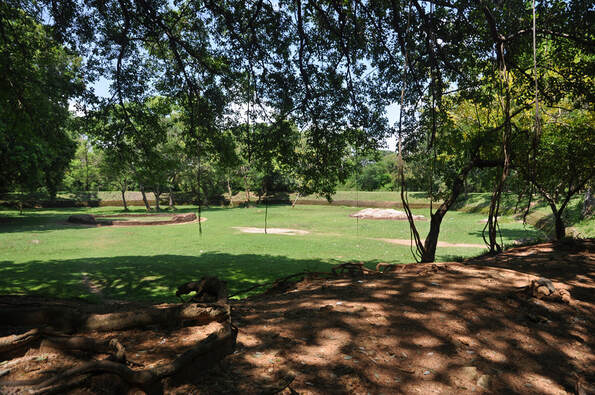
Further east, not far from this so-called tooth temple, is Panduwasnuwara's most remarkable construction, a rather large round rampart with a quite small round construction in the very centre. The rampart has a width of almost 7 meters at the base. The diameter is 90 meters. This circular rampart is a unique structure in Sri Lanka, there are no other circular ramparts on the island. The question what could have been the function or purpose of this structure is neither know from inscriptions nor from the chronicles. It’s somewhat enigmatic.
On first sight, the rampart looks like an arena, but it was certainly not, because the slopes of the brick construction have neither steps nor benches. The layout looks more like a round pond, a huge pokuna. But such a pond would be deepened, not simply being enclosed by a rampart on ground level. Furthermore, it would not make much sense, to have a construction with an interior room in the middle of a basin. The fantasy name Bisokotuwa interprets the ring parapet as a separate fortification, this is to say: as a circular citadel outside the rectangular main fortification of the royal palace. The round citadel is said to have been the place where Parakramabahu solemnly proclaimed his rule over "the seven countries", just before advancing to Polonnaruwa. As said, the function of this rotunda, for which there is no counterpart in Sri Lanka’s ancient architecture, remains puzzling. However, folk tales know to solve the puzzle.
Regional legend says that the round rampart was the enclosure of a lake with a thereby multiplicatively protected tower in the middle. The ruins of circular rampart or of the tower-like building in its centre are sometimes called Chakkrawalaya. The central tower is popularly known as Ektemge (Ek Tam Ge). The Sinhala name Ektenge derives from the Pali term found in the Mahvanasa chronicle: "gehe tan ekathunike", which translates toi “palace of one pillar”. This term might well refer to a tower-like structure. However, the Sinhala term "Ektemge" means "ivory tower". The Ektemge is said to be the prison cell in which Chitta, the daughter of King Panduvadeva, was held in captivity by her brothers. The princess was named after that room of the palace (which had only one pillar or resembled a pillar): Ummada Chitta (alias Unmada Chiththra or Unmansit) translates to “Chamber Chitta”.
|
Ummada Chitta was of such overwhelming beauty that she had to be protected from male admirers, for a very understandable reason: It had been predicted that if she ever gave birth to a son, he would kill all of her brothers for the sake of gaining sovereignty for himself. This is why she was kept in custody in a single palace room. However, it was bound to happen that all security measures failed to serve the purpose. The princess finally gave birth to a son, Pandukabhaya. In order to protect him, he was substituted by a female infant born to another woman. Pandukabhaya grew up among rural people. The famous story from Sri Lanka’s earliest Sinhalese period is told in Mahavansa chapter 9 (see grey box).
Secretly the little prince was sent away with flower ladies and came to Doramadalawa, which is usually identified as the area of the same name near Mihintale. However, local legend has it that this dafe haven was close to Panduwasnuwara. Pandukabhaya finally became the ruler of the country by killing all of his uncles except from one or two. Panukabhaya is most famous for chosing Anuradhapura as the island’s capital. So Ummada Chitta became the mother of the first Anuradhapura king. According to Mahavansa, the story takes place in Upatissagama. But this place, though not clearly identified, is considered to have been much further north, namely in the hinterland of Mannar, the landing port of the Sinhalese. The ancient Upatissagama, which was the first Sinhalese capital before Anuradhapura, would more probably have been in the area of today's Wilpattu National Park and Tantirimale. An alternative story told in Panduwasnuwara has it that this mysterious rotunda was the palace of a queen, which was connected to the royal palace by a secret underground tunnel. Furthermore, in the vicinity of the circular wall, an overgrown hill is said to be the tomb of Vijaya, the first Sinhalese king. |
Ummada Chitta, Princess in the towerIn the 9th chapter of the Mahavansa, the story of the birth of Pandukabhaya (Panduabhaya) is told as follows:
"THE queen bore ten sons and one daughter: the eldest of all was named ABHAYA, the youngest (child, the) daughter was named Cittia. When the brahmans skilled in sacred texts saw her they foretold: `For the sake of sovereignty will her son slay his uncles.' When the brothers resolved: `let us kill our young sister,' ABHAYA restrained them. In due time they lodged her in a chamber having but one pillar, and the entry thereto they made through the king's sleeping chamber; and within they placed a serving woman, and a hundred soldiers without. But since she (Citta) drove men mad by the, mere sight of her beauty, the name given to `her was lengthened by an epithet 'Ummadacitta `. […] When the son of prince Dighayu, Dighagamani, heard of Ummadacitta he went, driven by longing for her, to Upatissagama, and there sought out the ruler of the land. And this (latter) appointed him together with the vice-regent, to service at the royal court. Now (once) Citta saw Gamani in the place where he stood opposite her window, and, her heart on fire with love, she asked her serving-woman: `Who is that?' When she heard: `He is the son of thy uncle,' she trusted the matter to her attendant and he, being in league with her, fastened a hookladder to the window in the night,' climbed up, broke the window and so came in. So he had intercourse with her and did not go forth till break of day. And he returned there constantly, nor was he discovered, for there was no entry (to the chamber). And she became with child by him, and when the fruit of her womb was ripe the serving-woman told her mother, and the mother, having questioned her daughter, told the king. The king took counsel with his sons and said: `He too must be received among us; let us give her (in marriage) to him.' And saying: `If it is a son we will slay him'; they gave her to him. […] And Citta made her attendant find another woman who was near her delivery. And Citta bore a son but this woman bore a daughter. Citta caused a thousand (pieces of money) to be handed over to (the other) together with her own son, and the latter's daughter to be then brought to her and laid beside her. When the king's sons heard `a daughter is born', they were well pleased; but the two, mother and grandmother, joining the names of the grandfather and the eldest uncle gave the boy the name Panduabhaya." cited from: https://lakdiva.org/mahavamsa/chap009.html |
Museum of Panduwasnuwara
The museum is located close to the road. Studying the exhibits, western travellers might be surprised to find coins with inscriptions in Greek characters. However, western coins are not at all uncommonl finds in Sri Lanka, since Indian Ocean trade with the Mediterraneans, though on a lower scale, after the fall of the Roman Empire continued even in the Byzantine period, when Greek replaced Latin as the official language in inscriptions and other documents. Chinese coins have been found in Panduwasnuwara, too. Actually, coins of almost all Chinese emperors of the 10th to 13th century have been found in Sri Lanka.
A small bearded figure is reminiscent of the rock statue at the Potgul Vihara of Polonnaruwa, the exact identification of which has so far not been successful. Usually, it is called Parakramabahu statue, but it’s more likely that it depicts an Indian sage (a rishi). Also jewellery and pottery are on display in the small museum.
A small bearded figure is reminiscent of the rock statue at the Potgul Vihara of Polonnaruwa, the exact identification of which has so far not been successful. Usually, it is called Parakramabahu statue, but it’s more likely that it depicts an Indian sage (a rishi). Also jewellery and pottery are on display in the small museum.
The archaological site of Panduwasnuwara belongs to the divisional secretariat of the same name in Kurunegala District. The site is in the village of Kottambapitiya, 2.5 km east of Hettipola, halfway between Kurunegala and Chilaw. Panduwasnuwara is 65 km northeast of Negombo. The entrance to the archaeological site is at the B79 road from Wariyapola to Chilaw (Halavata), just south of the road. At the road is a small museum with a ticket booth.

